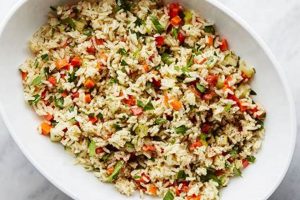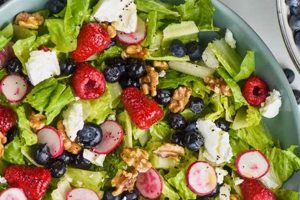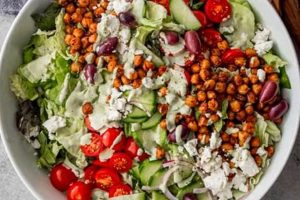Crisp, refreshing, and adaptable, this dish typically combines shredded cabbage, cooked ramen noodles (often discarding the flavor packet), and a variety of other vegetables. Common additions include carrots, bell peppers, edamame, and green onions. A flavorful dressing, often based on soy sauce, vinegar, sesame oil, and ginger, binds the ingredients together. Variations can incorporate protein such as shredded chicken, shrimp, or tofu, transforming the salad into a complete meal. A simple example might feature shredded green cabbage, ramen noodles, sliced carrots, and a dressing of rice vinegar, soy sauce, and sesame oil.
Such salads offer a compelling blend of textures and flavors, balancing the crunch of raw vegetables with the satisfying chewiness of noodles. They are economical, easily customizable to individual preferences, and can be prepared quickly, making them ideal for weeknight meals or potlucks. Furthermore, they offer a healthy way to enjoy ramen, moving beyond the typical high-sodium instant noodle preparation. While the specific origin of this dish is difficult to pinpoint, it likely draws inspiration from Asian cuisine, reflecting broader trends towards lighter, healthier meals incorporating readily available ingredients.
Further exploration will delve into specific variations, including detailed recipes, ingredient substitutions for dietary restrictions, and tips for achieving optimal flavor and texture.
Tips for Cabbage Ramen Noodle Salad Recipes
Optimizing ingredient preparation and flavor combinations elevates this simple dish. Attention to detail ensures a satisfying textural and flavor profile.
Tip 1: Crisp Cabbage is Key: Choose fresh, firm cabbage. Finely shredding ensures optimal texture and allows the dressing to coat evenly. Soaking shredded cabbage in ice water for a short period before assembling the salad enhances crispness.
Tip 2: Noodle Mastery: Cook ramen noodles according to package directions, but avoid overcooking. Rinsing the noodles under cold water after cooking stops the cooking process and removes excess starch, preventing a gummy texture.
Tip 3: Dressing Dynamics: Freshly prepared dressings provide the best flavor. Balance sweet, sour, salty, and umami elements. Allow the salad to marinate briefly for optimal flavor penetration, but avoid over-marinating, which can make the cabbage soggy.
Tip 4: Vegetable Variety: Explore diverse vegetables beyond the standard carrots and bell peppers. Consider shredded broccoli, snap peas, bean sprouts, or julienned cucumbers.
Tip 5: Protein Power: Enhance the salad’s nutritional value and make it a complete meal by adding protein. Grilled chicken or shrimp, pan-fried tofu, or even a sprinkle of toasted sesame seeds contribute both flavor and substance.
Tip 6: Garnish with Purpose: Toasted sesame seeds, chopped cilantro, or a sprinkle of crushed peanuts add visual appeal and enhance the flavor profile. A squeeze of lime juice just before serving adds brightness.
Tip 7: Storage Solutions: Store leftover salad and dressing separately to maintain optimal texture. Combine just before serving.
By following these tips, one can create a flavorful and satisfying salad experience, maximizing the potential of this versatile dish.
These insights provide a foundation for crafting exceptional variations, setting the stage for a deeper exploration of recipe possibilities.
1. Fresh, Crisp Cabbage
Fresh, crisp cabbage forms the foundation of a successful cabbage ramen noodle salad. Its structural integrity provides textural contrast to the softened noodles and other ingredients. A crisp texture offers a satisfying counterpoint to the other elements, contributing to a more enjoyable eating experience. Without this crucial element, the salad can become limp and unappetizing. For instance, using cabbage that is past its prime can result in an unpleasant, wilted texture that detracts from the overall dish.
The choice of cabbage variety also influences the final outcome. While green cabbage is commonly used, Napa cabbage offers a milder, sweeter flavor and a more delicate texture. Savoy cabbage, with its crinkled leaves, adds a visually interesting element and a slightly peppery flavor. The selection of a specific variety should align with desired flavor profiles and aesthetic considerations. Consider a salad featuring Napa cabbage and a light, citrusy dressing for a refreshing summer meal. Alternatively, a heartier salad incorporating savoy cabbage, shredded chicken, and a robust sesame dressing might better suit a colder evening.
Proper storage and handling are essential to maintain cabbage freshness. Refrigeration in a crisper drawer helps preserve optimal texture. Avoiding pre-shredding until just before use prevents premature wilting and oxidation. These practical steps ensure the cabbage remains a vibrant and appealing component of the salad. Ultimately, prioritizing fresh, crisp cabbage contributes significantly to the overall success of a cabbage ramen noodle salad recipe.
2. Flavorful Dressings
Flavorful dressings are essential to successful cabbage ramen noodle salad recipes. They provide the unifying element, binding the diverse ingredients and imparting a cohesive flavor profile. The dressing’s role extends beyond simply adding flavor; it also contributes to the overall texture and moistness of the salad. A well-balanced dressing elevates the dish from a simple combination of ingredients to a harmonious culinary experience. Careful consideration of flavor profiles and ingredient compatibility ensures a dressing that complements, rather than overwhelms, the other components.
- Acidity
Acidity provides brightness and balances the richness of the noodles and other ingredients. Common sources include rice vinegar, apple cider vinegar, and citrus juices. The level of acidity should be adjusted to complement the other flavors in the dressing and the overall salad composition. For example, a dressing with a higher proportion of vinegar might pair well with a salad featuring bolder flavors, while a lighter touch of citrus juice might be preferred in a salad with more delicate ingredients. The acidity also plays a role in preserving the crispness of the cabbage.
- Salt and Umami
Salt enhances the other flavors in the dressing and the salad as a whole. Soy sauce, tamari, or fish sauce contribute saltiness as well as umami, a savory, fifth taste. These ingredients add depth and complexity to the dressing, enhancing its overall impact. Balancing saltiness with other flavor components is essential to avoid overpowering the delicate flavors of the vegetables. For example, a dressing relying on soy sauce for saltiness might benefit from a touch of sweetness to create a more balanced profile.
- Sweetness
A touch of sweetness rounds out the flavor profile and balances the acidity and saltiness. Sugar, honey, maple syrup, or mirin can be used to achieve the desired level of sweetness. The choice of sweetener influences the final flavor and texture of the dressing. For instance, honey adds a subtle floral note, while maple syrup contributes a richer, more complex sweetness. The level of sweetness should be carefully calibrated to prevent the dressing from becoming cloying.
- Oils and Fats
Oils and fats contribute richness and help to emulsify the dressing, creating a smooth, cohesive texture. Sesame oil, peanut oil, or neutral oils like canola or grapeseed oil are common choices. The type of oil influences the flavor profile and can impart distinct aromatic notes. Sesame oil, for example, provides a nutty, toasted flavor, while peanut oil offers a milder, more subtle taste. The amount of oil used determines the richness and viscosity of the dressing.
The interplay of these elements creates a dressing that enhances the overall flavor and texture of the cabbage ramen noodle salad. The careful balancing of these components ensures that the dressing complements the other ingredients, creating a harmonious and satisfying dish. Understanding these facets enables the creation of dressings tailored to specific flavor preferences and dietary needs, demonstrating the versatility and adaptability of this culinary staple.
3. Crunchy Vegetables
Crunchy vegetables play a vital role in cabbage ramen noodle salad recipes, contributing textural complexity and enhancing the overall sensory experience. Their contrasting texture against the softened noodles and creamy dressing creates a dynamic interplay that elevates the dish beyond a simple combination of ingredients. A careful selection of crunchy vegetables not only adds textural interest but also introduces diverse flavors and nutritional value.
- Carrots
Carrots offer a familiar sweetness and a satisfying crunch. Their vibrant orange color adds visual appeal, while their readily available nature makes them a practical choice. Julienned or shredded carrots integrate seamlessly into the salad, providing a consistent textural element throughout. The subtle sweetness of carrots balances the savory notes of the dressing and other ingredients.
- Bell Peppers
Bell peppers introduce a crisp, juicy texture and a slightly sweet, vegetal flavor. Their availability in various colorsred, yellow, orange, and greenallows for customization of both flavor and visual presentation. Thinly sliced bell peppers add a refreshing element to the salad, while their vibrant colors enhance its aesthetic appeal.
- Cucumbers
Cucumbers provide a refreshing coolness and a distinct crunch. Their high water content contributes to a light, hydrating element in the salad. Thinly sliced or diced cucumbers add a crisp, clean flavor that balances richer components of the dressing. English cucumbers, with their thinner skin and fewer seeds, are particularly well-suited for this application.
- Other Crunchy Vegetables
Beyond the common choices, other crunchy vegetables offer opportunities for flavor and texture exploration. Shredded broccoli stems, snap peas, bean sprouts, or chopped celery can introduce unique flavors and textures, further diversifying the salad. Incorporating less common vegetables expands the nutritional profile and adds an element of culinary creativity.
The strategic incorporation of crunchy vegetables enhances the sensory experience of cabbage ramen noodle salad recipes. These elements contribute not only textural contrast but also diverse flavors and nutritional benefits, transforming a simple dish into a more complex and satisfying culinary creation. Balancing these crunchy elements with the softer noodles and the richness of the dressing is key to achieving a harmonious and well-rounded flavor profile.
4. Protein Additions
Protein additions transform cabbage ramen noodle salad recipes from a side dish or light snack into a more substantial and nutritionally complete meal. Incorporating protein enhances satiety, contributing to a more satisfying dining experience. This addition also broadens the recipe’s appeal, offering a more versatile and customizable dish adaptable to various dietary needs and preferences. The choice of protein significantly influences the overall flavor profile and nutritional value of the salad. For example, grilled chicken breast provides a lean protein source with a relatively neutral flavor that readily absorbs the flavors of the dressing. Tofu, a plant-based protein, offers a versatile option adaptable to various flavor profiles, readily absorbing marinades and sauces.
The method of protein preparation further impacts the final result. Grilled or roasted proteins offer a smoky char and a satisfying texture, while pan-fried or seared proteins develop a flavorful crust. Alternatively, shredded rotisserie chicken or pre-cooked shrimp provide convenient shortcuts for busy weeknight meals. The chosen protein and its preparation should complement the other ingredients in the salad. For instance, a salad featuring a spicy peanut dressing might pair well with seared tofu, while a lighter vinaigrette might complement flaky grilled fish. Consider the interplay of flavors and textures when selecting and preparing the protein component.
Strategic protein inclusion elevates cabbage ramen noodle salads, offering nutritional benefits and expanding culinary possibilities. Careful consideration of protein choices and preparation methods allows for customization to individual preferences and dietary requirements, enhancing the versatility and appeal of this adaptable dish. Understanding the impact of protein additions empowers culinary exploration, leading to more satisfying and nutritionally balanced meals.
5. Textural Balance
Textural balance is paramount in achieving a successful cabbage ramen noodle salad recipe. This balance hinges on a harmonious interplay of contrasting yet complementary textures, creating a dynamic and satisfying sensory experience. The inherent textural diversity within these saladsthe crispness of raw vegetables, the chewiness of noodles, and the potential addition of crunchy toppings or proteinoffers a unique opportunity to explore and exploit this principle. Without this careful consideration, the salad can become monotonous and lack the engaging complexity that elevates it beyond a simple mix of ingredients. For instance, a salad composed solely of soft ingredients would lack the stimulating contrast that a well-balanced textural profile provides. Conversely, an overabundance of crunchy elements could overwhelm the palate and detract from the overall enjoyment.
The interplay between textures contributes significantly to the overall enjoyment of the dish. The crispness of the cabbage, for example, offers a refreshing counterpoint to the soft, chewy noodles. Adding elements like toasted sesame seeds or chopped peanuts introduces a welcome crunch, while the inclusion of proteins such as grilled chicken or seared tofu provides a more substantial, chewier element. This dynamic interplay keeps the palate engaged and prevents the experience from becoming one-dimensional. Consider a salad with tender ramen noodles, crisp shredded cabbage, crunchy chopped peanuts, and succulent grilled chicken. Each bite offers a stimulating combination of textures, enhancing the overall dining experience. Conversely, a salad lacking these textural variations might feel less satisfying and less engaging.
Achieving textural balance requires careful consideration of ingredient selection and preparation. Properly cooked, yet not overcooked, noodles provide the desired chewiness. Maintaining the crispness of vegetables through appropriate storage and handling, as well as incorporating a variety of textural elements, contributes to a more dynamic and enjoyable salad. Understanding the impact of different ingredients and preparation methods on the final textural profile empowers culinary creativity and allows for the creation of truly satisfying and well-balanced cabbage ramen noodle salads.
Frequently Asked Questions
This section addresses common inquiries regarding cabbage ramen noodle salad recipes, providing concise and informative responses.
Question 1: Can the flavor packet included with the ramen noodles be used in the dressing?
While the flavor packet can be used, it often contains high levels of sodium. Utilizing fresh ingredients allows for greater control over sodium content and flavor profiles. Adjusting seasonings to personal preference yields a more balanced and healthful outcome.
Question 2: How long can this salad be stored in the refrigerator?
Storing the dressing and salad components separately maximizes shelf life. Combined, the salad ideally should be consumed within 24 hours to maintain optimal texture and prevent the cabbage from becoming soggy. Stored separately, the components can last up to three days refrigerated.
Question 3: What are suitable substitutions for individuals with gluten sensitivities?
Gluten-free ramen noodles are readily available. Alternatively, rice noodles, kelp noodles, or even thinly sliced zucchini can be substituted. Ensuring all other ingredients, particularly sauces and dressings, are gluten-free is essential.
Question 4: Can this salad be prepared in advance for a potluck or picnic?
Yes, but keep the dressing separate and combine just before serving to prevent the salad from becoming soggy. Transporting components in separate containers maintains optimal texture and freshness.
Question 5: What are some alternatives to cabbage if desired?
While cabbage offers a distinctive texture and flavor, shredded lettuce, such as romaine or iceberg, can be substituted. However, this alteration will impact the overall texture and longevity of the salad’s crispness.
Question 6: How can nutritional value be maximized?
Incorporating a variety of colorful vegetables expands the range of vitamins and minerals. Adding lean protein, such as grilled chicken or tofu, enhances the protein content and increases satiety. Utilizing a homemade dressing allows for control over sodium and sugar levels.
Careful attention to ingredient selection, preparation methods, and storage practices ensures optimal flavor, texture, and nutritional value in cabbage ramen noodle salads.
For those seeking further culinary inspiration, the following section presents variations on this adaptable dish.
Cabbage Ramen Noodle Salad Recipes
Cabbage ramen noodle salad recipes offer a versatile and adaptable culinary canvas. Exploration of this dish reveals the importance of fresh, crisp cabbage as a foundation, the transformative power of flavorful dressings, the textural interplay of crunchy vegetables, and the nutritional enhancement provided by protein additions. Achieving a harmonious balance of these elements is key to creating a truly satisfying and enjoyable salad. Careful consideration of ingredient selection, preparation techniques, and storage practices ensures optimal flavor, texture, and nutritional value.
This exploration provides a framework for culinary creativity, encouraging further experimentation and adaptation to individual preferences and dietary needs. The potential for customization within these recipes offers a gateway to a diverse range of flavor profiles and culinary experiences. Continued exploration promises exciting possibilities for this adaptable and satisfying dish.






